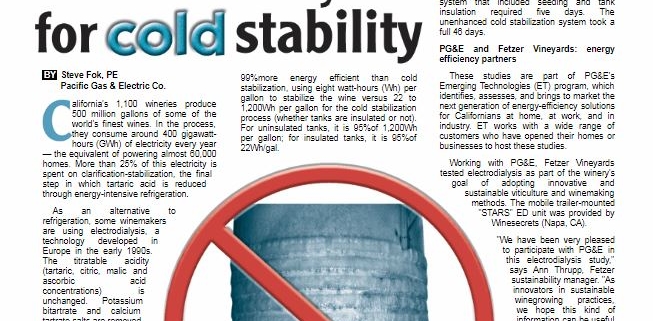PG&E studies electrodialysis for cold stability
California’s 1,100 wineries produce 500 million gallons of some of the world’s finest wines. In the process, they consume around 400 gigawatt-hours (GWh) of electricity every year — the equivalent of powering almost 60,000 homes. More than 25% of this electricity is spent on clarification-stabilization, the final step in which tartaric acid is reduced through energy-intensive refrigeration.
As an alternative to refrigeration, some winemakers are using electrodialysis, a technology developed in Europe in the early 1990s. The titratable acidity (tartaric, citric, malic and ascorbic acid concentrations) is unchanged. Potassium bitartrate and calcium tartrate salts are removed from solution.
Pacific Gas & Electric Company (PG&E) commissioned two studies at California wineries, with the goal of determining the most energy-efficient methods to stabilize wines. The first study, which took place at Fetzer Vineyards (Hopland, CA), compared the energy consumption of electrodialysis to that of cold stabilization. The second study compared the energy efficiency of cold stabilization at Fetzer Vineyards to that at another site, where cold stabilization was enhanced by seeding, using insulated tanks, and other factors.
Despite using more water, the electrodialysis process was found to be up to
99%more energy efficient than cold stabilization, using eight watt-hours (Wh) per gallon to stabilize the wine versus 22 to 1,200Wh per gallon for the cold stabilization process (whether tanks are insulated or not). For uninsulated tanks, it is 95%of 1,200Wh per gallon; for insulated tanks, it is 95%of 22Wh/gal.
Energy efficiency of the cold stabilization process varied greatly depending on a number of factors, including tank insulation, wine type, seeding, and duration of stabilization. Electrodialysis was shown to maintain wine quality, reduce wine loss, and reduce processing time from weeks to days.
Electrodialysis stabilized wine in just a little over one day, while the cold stabilization system that included seeding and tank insulation required five days. The unenhanced cold stabilization system took a full 46 days.
PG&E and Fetzer Vineyards: energy efficiency partners
These studies are part of PG&E’s Emerging Technologies (ET) program, which identifies, assesses, and brings to market the next generation of energy-efficiency solutions for Californians at home, at work, and in industry. ET works with a wide range of customers who have opened their homes or businesses to host these studies.
Working with PG&E, Fetzer Vineyards tested electrodialysis as part of the winery’s goal of adopting innovative and sustainable viticulture and winemaking methods. The mobile trailer-mounted « STARS » ED unit was provided by Winesecrets (Napa, CA).
« We have been very pleased to participate with PG&E in this electrodialysis study, » says Ann Thrupp, Fetzer sustainability manager. « As innovators in sustainable winegrowing practices, we hope this kind of information can be useful to others who are interested in saving energy and gaining efficiency benefits from new technologies. »
Science behind tartrate stabilization
As the final step before bottling, stabilization reduces the concentration of potassium bitartrate (cream of tartar) in wine. For customers, this means no « wine diamonds » will be visible at the bottom of a chilled bottle of wine. Traditionally, this is accomplished by chilling the wine to around 27°F for a period of 1½ to 3 weeks, depending on how quickly the potassium bitartrate is crystallized.
BY Steve Fok, PE
Pacific Gas & Electric Co.
https://www.practicalwinery.com/sepoct08/page1.htm



